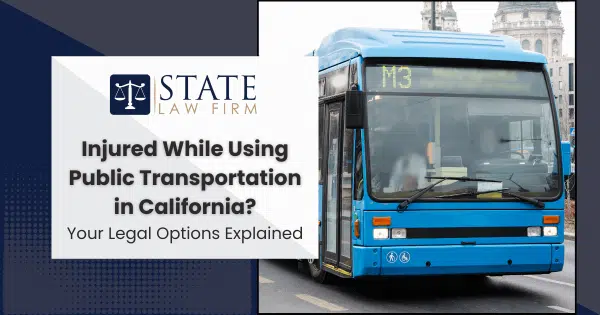Public transportation is supposed to be the safe, stress-free option. You sit down, tap your card, and trust that the driver, the agency, and the equipment will do their jobs.
Yet every year, thousands of people are hurt in bus, train, and other transit incidents across the United States, and California consistently reports some of the highest numbers of mass-transit deaths and injuries nationwide.
A single moment on a bus, light rail, or commuter train can leave you facing medical bills, missed work, and a long recovery.
If you were injured while using public transportation in California, you do not just have to accept what happened as bad luck. You may have important legal rights, but transit cases follow different rules than a typical car accident, especially when the defendant is a city, county, or state agency. In this guide, State Law Firm walks through what you need to know so you can protect yourself and avoid costly mistakes.
Understanding Public Transportation Accidents in California
“Public transportation” in California covers a lot of ground, including:
- City buses, rapid buses, and neighborhood shuttles
- Light rail and commuter trains
- County and regional transit agencies
- Public trolleys, streetcars, and trams
- Paratransit and dial-a-ride services for people with disabilities
From a big-picture standpoint, public transit is still much safer, mile for mile, than driving your own car. But when something does go wrong, it often goes very wrong. A single bus crash can injure dozens of people at once. A train derailment or a collision at a crossing can leave passengers and bystanders with catastrophic injuries.
Common types of public transportation incidents include:
- Bus or train collisions with cars, trucks, or motorcycles
- Sudden stops, swerves, or jerks that throw passengers from their seats
- Boarding and exiting injuries, including falls on stairs or from platforms
- Pedestrian knockdowns in crosswalks or bus zones
- Slip and falls inside the vehicle or at a station due to spills, debris, or broken flooring
- Equipment failures, such as faulty brakes, doors that close on riders, or defective handrails
The bottom line: you do not need a spectacular derailment or headline-grabbing crash for your case to matter. If a transit agency or its employees did not meet their legal obligations and you were hurt as a result, you have the right to ask who is responsible and how they are going to make it right.
Your Rights as a Passenger: Who Is Liable?
Under California law, most public transportation providers that carry passengers for pay are treated as “common carriers.” That legal label matters. It means the transit operator must use the highest level of care that is practical under the circumstances to keep passengers safe, not just “ordinary” care. A common carrier must:
- Keep vehicles reasonably safe, maintained, and fit for use
- Take reasonable steps to protect passengers from foreseeable dangers, including unsafe drivers or conditions
- Avoid overcrowding and other practices that increase risk
When an injury occurs, one of the first legal questions is who failed in that duty of care. Depending on how the accident happened, potentially responsible parties may include:
- The public transit agency itself, for poor training, supervision, maintenance, or dangerous policies
- The bus or train operator, for speeding, distracted driving, running a red light, or failing to secure passengers
- Another driver on the road who caused a crash with the bus or train
- A private contractor responsible for maintenance, construction near the route, or station management
- Manufacturers of defective parts, such as brakes, steering components, or doors
- Security contractors or staff, if the injury involved preventable violence or criminal activity
In many public transportation cases, there are multiple layers of responsibility. For example, a bus driver may have been speeding, but the agency might also be liable for pushing unrealistic schedules that encourage unsafe driving. A skilled attorney can help untangle those layers, identify every potential defendant, and build a claim that does not leave money on the table.
As a passenger, you are not expected to predict or control any of this. Your main responsibility is to act reasonably and follow basic safety rules. When you do that and you are still hurt, the law is designed to ask hard questions of the people and entities that had the power to prevent your injury.
The Claims Process: Steps To Take After a Transit Injury
If you were hurt on public transportation, what you do in the hours and days that follow can make a real difference in your case. Try to follow these steps as closely as your medical condition allows.
1. Put safety and medical care first
- Call 911 or ask someone nearby to do it if you suspect a serious injury.
- Tell first responders about every area of pain, even if you think it is “minor” in the moment. Head, neck, and back injuries, as well as concussions, often feel worse later.
- If you do not go to the hospital from the scene, schedule an urgent care or doctor’s visit as soon as possible and describe that this was a transit-related injury.
2. Report the incident
- Tell the bus driver, train operator, or station staff that you were injured and ask how to file an incident report.
- If the transit agency has an online or phone reporting system, submit a written report and save a copy or screenshot.
- Note any incident or report number you are given.
3. Gather evidence while the scene is fresh
- Take photos or video of the vehicle, your surroundings, visible injuries, and anything that looks unsafe or unusual.
- Get names and contact information for witnesses, including fellow passengers.
- Preserve your transit pass or ticket and any receipts that can confirm you were on that particular bus or train.
You do not need to investigate like a lawyer. But simple steps to document the scene can help an attorney later prove what happened when memories fade and agencies close ranks.
4. Track your damages
From day one, create a folder or digital file where you collect:
- Medical bills and records
- Prescription and over-the-counter medication receipts
- Proof of missed work and lost wages
- Transportation costs to medical appointments
- Journals or notes about pain levels, sleep disturbances, and activity limitations
This is the foundation of your damages claim. It shows how the injury has changed your life in concrete, day-to-day ways.
5. Be cautious about what you sign or say
Transit agencies and their insurers may contact you quickly, asking for recorded statements or offering a small settlement. Before giving any detailed statement or signing any release:
- Avoid minimizing your injuries, speculating, or guessing about what happened.
- Politely decline to sign anything until you have spoken with an attorney.
- Remember that early offers are often designed to close the case cheaply, not fairly.
A lawyer can help you understand what your case may actually be worth before you agree to anything.
Navigating Government Immunity and Strict Filing Deadlines
One of the most confusing parts of public transportation cases in California is that many transit agencies are government entities. That means they are protected by special rules under the California Government Claims Act.
The key difference from a normal car accident case is timing. In a typical personal injury claim against a private party, you usually have up to two years from the date of the injury to file a lawsuit in court. When a public agency is involved, the clock starts much earlier.
In most public transit injury cases involving a city, county, or state agency, you must:
- File a written “government claim” with the correct agency, usually within six months of the date of the incident.
- Wait for the agency to accept, reject, or ignore the claim.
- If the agency denies the claim, file your lawsuit in court within a short window, often six months from the date of denial.
If you miss the initial government claim deadline, the court can throw out your case, even if your injuries are serious and the agency was clearly at fault. There are limited exceptions for minors and certain disabilities, but relying on those exceptions is risky.
Private transportation companies that are not government entities usually follow the standard statute of limitations for personal injury instead of the shorter government-claim deadline. One reason to talk to a lawyer early is to figure out which category your case falls into and which deadlines apply.
The Role of a Personal Injury Lawyer in Transit Accident Cases
Government rules, short deadlines, and overlapping layers of responsibility make public transportation cases more complex than a typical fender bender. A personal injury lawyer who handles California transit cases can:
- Identify every potentially liable party and applicable insurance policy
- Obtain surveillance footage, internal logs, and maintenance records before they disappear
- Work with accident reconstruction experts and medical professionals to explain what happened and how it affected you
- Make sure your government claim is filed on time, with enough detail to preserve your rights
- Negotiate with the agency or insurer from a position of strength and take the case to court if they refuse to be fair
At State Law Firm, we think about public transit cases the same way we think about complex institutional negligence in other settings, like nursing homes. The people who trusted the system deserve to be treated as humans, not case numbers.
The same mindset applies here. You should not have to navigate overlapping state codes, insurance coverage issues, and government procedures on your own while you are trying to heal. A good lawyer’s job is to shoulder that burden, so you can focus on your recovery.
Protect Your Rights After a Public Transportation Injury
Being injured while using public transportation in California can feel overwhelming. You may be unsure whether the driver, the agency, another motorist, or someone else is to blame. You may also be frustrated by confusing forms, short deadlines, and agencies that seem more interested in protecting themselves than in helping you.
You do not have to figure this out alone. If you were hurt on a bus, train, shuttle, or other public transit service, talk with a California personal injury lawyer as soon as you can. A brief conversation can clarify your options, preserve your right to compensation, and help you decide what to do next with a clear head.
If you are ready to discuss your situation, State Law Firm is here to listen, explain your options in plain English, and help you decide whether a claim makes sense for you and your family.


